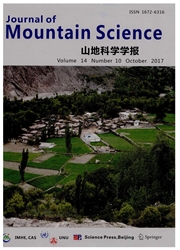

 中文摘要:
中文摘要:
这研究是探索一个合适的方法分类地形,以便为社区坐在多山的区域支持决策。它首先为坐的社区(LCCS ) 建议地形分类有它的合理性和选择参数的详细讨论的方法。这个方法然后在 Quxian 被测试并且验证县。LCCS 方法必要二等级的参数,把相对地势用作首先分级的参数,是倾斜第二,由合成进程列在后面形成一个合适的地形分类系统。由在 Quxian 县使用 LCCS 方法,结果显示出那它分水岭到的使用识别高度资料概念的 geomorphometric 单位,和它的使用,能有效地根据本地文化传统,和经济、环境的条件分类地形。确认结果显示出那比作常规方法,到民族的 LCCS 方法尊重每天由于它的自底向上的途径经历。它当为社区开发选择地点时,最小化骚乱到性质的不仅帮助,而且帮助到准备更精确的陆地管理政策,它最大化农业生产并且最小化地面转变。
 英文摘要:
英文摘要:
This study is to explore a suitable method to classify landform, in order to support the decision making for community siting in mountainous areas.It first proposes the landform classification for community siting(LCCS) method with detailed discussions on its rationality and the chosen parameters.This method is then tested and verified in Quxian county.The LCCS method entails twograde parameters, which uses relative relief as the first grading parameter, slope as the second, followed by a synthesis process to form a suitable landform classification system.By applying the LCCS method in Quxian county, the result shows that its use of watershed to identify geomorphometric units, and its use of the altitude datum concept, can effectively classify landform according to the local cultural traditions, and the economic and environmental conditions.The verification result shows that comparing to the conventional methods, the LCCS method respects to people’s daily experience due to its bottom-up approach.It not only help to minimize the disturbance to the nature when choosing locations for community development, but also helps to prepare more precise land management policies,which maximizes agricultural production and minimizes terrain transformation.
 同期刊论文项目
同期刊论文项目
 同项目期刊论文
同项目期刊论文
 期刊信息
期刊信息
